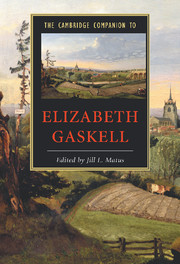Book contents
- Frontmatter
- 1 Introduction
- 2 The life and letters of E. C. Gaskell
- 3 Mary Barton and North and South
- 4 Cranford and Ruth
- 5 Elizabeth Gaskell’s The Life of Charlotte Brontë
- 6 Sylvia’s Lovers and other historical fiction
- 7 Cousin Phillis, Wives and Daughters, and modernity
- 8 Elizabeth Gaskell’s shorter pieces
- 9 Gaskell, gender, and the family
- 10 Elizabeth Gaskell and social transformation
- 11 Unitarian dissent
- 12 Gaskell then and now
- Guide to further reading
- Index
- Series List
4 - Cranford and Ruth
Published online by Cambridge University Press: 28 May 2007
- Frontmatter
- 1 Introduction
- 2 The life and letters of E. C. Gaskell
- 3 Mary Barton and North and South
- 4 Cranford and Ruth
- 5 Elizabeth Gaskell’s The Life of Charlotte Brontë
- 6 Sylvia’s Lovers and other historical fiction
- 7 Cousin Phillis, Wives and Daughters, and modernity
- 8 Elizabeth Gaskell’s shorter pieces
- 9 Gaskell, gender, and the family
- 10 Elizabeth Gaskell and social transformation
- 11 Unitarian dissent
- 12 Gaskell then and now
- Guide to further reading
- Index
- Series List
Summary
“The use made of fragments and small opportunities; . . . [t]hings that many would despise, and actions which it seemed scarcely worthwhile to perform, were all attended to in Cranford.”
Elizabeth Gaskell, Cranford (1853)“[A] vision of a man seemed to haunt the kitchen.”
Elizabeth Gaskell, Cranford (1853)Cranford and Ruth were written in tandem. For three years Gaskell ''vibrated'' back and forth between the two projects (to borrow the term she uses to describe the movement of Cranford's narrator), and then Cranford, which began as a series of stories Gaskell wrote for Charles Dickens's weekly journal Household Words, was published in one volume in June of 1853, Ruth in January of that same year. Both texts are centrally concerned with the status of women and the nature of female community; both are said to draw on Gaskell's memories of having been raised in the all-female company of her aunts Hannah Lumb and Abigail Holland in the small town of Knutsford south of Manchester. But the two works differ radically from one another, offering alternative visions, genres, and sensibilities. One is satiric, the other fairly sentimental; one is generally comic, the other chiefly tragic. One explores the nature of village life while the other focuses on a few central characters and families; one is ostensibly though not exclusively interested in what are conventionally viewed as trivial feminine concerns (tea and headgear) while the other seeks to intervene in social debates crucial to the status of Victorian women (prostitution and philanthropy).
- Type
- Chapter
- Information
- The Cambridge Companion to Elizabeth Gaskell , pp. 46 - 58Publisher: Cambridge University PressPrint publication year: 2007
- 5
- Cited by

